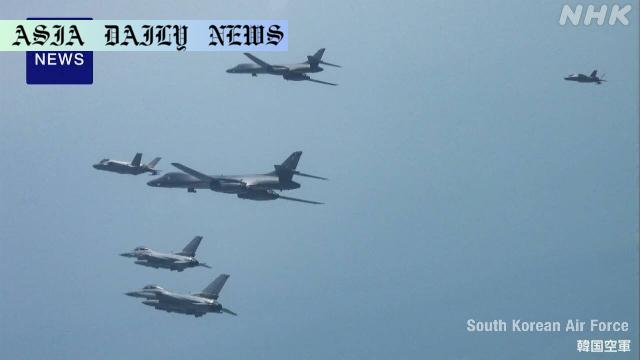B-1B bombers: North Korea denounces joint US-South Korean drills, calling them a grave provocation escalating tensions.
- North Korea condemns US-South Korea air drill with B-1B bombers.
- The drills are seen as a grave provocation increasing tensions.
- The US continues deploying advanced weapons near the peninsula.

Introduction to the Tensions
The geopolitical dynamics of the Korean Peninsula have once again reached a hazardous peak following the recent joint air drill conducted by the United States and South Korea. These drills involved the deployment of B-1B bombers, aircraft with the capacity to reach North Korea within two hours from their base in Guam, and capable of carrying substantial ammunition. In response to this event, North Korea has released a strongly-worded statement denouncing the operation, labeling it as a ‘grave provocation.’ According to the North Korean defense ministry, the provocative actions of the US and South Korea escalate military tensions in the region, bringing it to a perilously dangerous level.
The Role of B-1B Bombers
B-1B bombers, often referred to as the backbone of the US Air Force’s long-range strike force, play a pivotal role in projecting military power in the Asia-Pacific region. These bombers were specifically designed for high-speed, long-range missions, boasting the ability to evade radar detection. As they can reach the Korean Peninsula in under two hours, their presence in drills is perceived by North Korea as an overt display of force. This marks yet another chapter in the long history of such deployments, with previous drills also involving these formidable aircrafts resulting in steadfast condemnation from Pyongyang.
North Korea’s Standpoint
In a statement published in the ruling Workers’ Party newspaper, a spokesperson from North Korea’s defense ministry outlined their view of the US and South Korea’s actions. They claim that the United States continues to exacerbate conditions in the region with frequent deployment of aircraft carriers and nuclear submarines near the peninsula. The drills reportedly signify an ongoing strategy by the US to militarize the area further. North Korea’s response is clear—they will counter such actions with powerful deterrence measures, signaling that they will not shy away from defending their sovereignty and security ambitions.
A Continuing Pattern of Provocation
Tuesday’s air drill follows a familiar pattern of joint military exercises by the US and South Korea that Pyongyang deems provocative. Earlier this year, similar criticism occurred when B-1B bombers featured in February drills. The repetition of such maneuvers drives a narrative of strategic and military pressure from the US and its South Korean ally against North Korea, further complicating the already intricate security concerns of the Asian region. North Korea perceives these actions as disrespectful to its calls for a de-escalation of military aggression and has continually issued statements directly addressing the threat these drills pose to regional security.
Future Implications
The persistence of such exercises and their responses represent a deep-seated friction that reverberates across international relations. As North Korea ramps up its rhetoric, warning of potential retaliation, and the US remains firm in its intent to ensure South Korean security, the likelihood of miscalculation grows. Regional stakeholders and global superpowers keep close watch as such actions could spill into larger conflicts. The Korean Peninsula remains a focal point in any discussions surrounding global security architecture.



Commentary
The Persistent Tug-of-War
The recent uproar from North Korea over the joint US-South Korea air drills unveils the persistent tug-of-war that restlessly defines the Korean Peninsula. Each year, such exercises encapsulate the tension between force demonstration on one side and its interpretation as provocation on the other. The military maneuvers speak volumes, portraying America’s readiness to counter North Korea’s threats while supporting its allies in the region. However, from North Korea’s standpoint, these operations represent an antagonistic act that magnifies insecurity, justifying their adamant stance and fiery rhetoric.
Escalation or Security?
The role of the B-1B bombers is emblematic—its sleek, formidable presence visualizes the power struggle in the region. The reported capability to strike with substantial firepower within mere hours undoubtedly amplifies fears and indirectly prompts North Korea to respond with calls for defense measures. Tipping the delicate scales between ensuring security for South Korea while mitigating potential escalations is critical. Still, with the continued show of power from both sides, achieving equilibrium becomes increasingly complex.
A Need for Diplomatic Resolution
While military operations demonstrate tangible defense postures, they can also work against progress in dialogue. Today’s hyper-charged global lens demands a careful evaluation of actions that might inadvertently foster misunderstandings, especially between militarily capable states. Both the US and North Korea spare no words, making it evident that every drill and every response is as much a statement to the domestic audience as it is on the international stage. Ultimately, the region’s fragile peace is upheld not by B-1B bombers or provocations but through genuine efforts at understanding and resolution—a concept elusive but critical for stability in the Korean Peninsula.